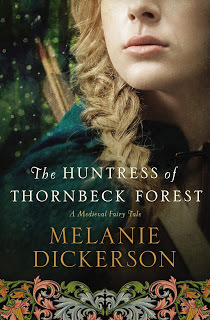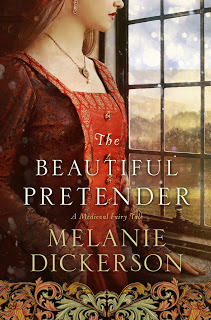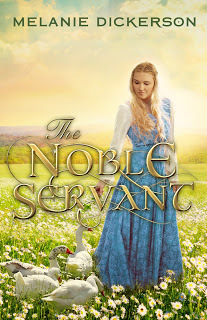Conflict and Tension Part 3, When to Resolve Conflict
Melanie Dickerson here. Have you ever started a story thinking you had this amazing conflict that would keep your readers enthralled until the end of the story, only to realize early on that it’s not feasible to keep this conflict going for the whole story? You don't want the story to get boring.
I used to panic when this would happen, but I realized something. Rather than dragging out a problem beyond believability, why not just let that conflict be resolved—and add a new conflict?
 Crestock.com
Crestock.comI try to let my conflicts resolve themselves in a believable amount of time. I don't want the story to drag, and it will if there isn't enough believable conflict. The trick is to make sure there are other conflicts that will take prominence as soon as that other conflict, or problem, is resolved.
For example, in one of my favorite movies, Penelope, starring Christina Ricci and James McAvoy, Penelope’s parents hide their daughter from the public, since she has the nose and ears of a pig, as they search for a society blue-blood to marry her and break the curse. This tension of hiding keeps the viewer wondering what will happen if and when people see Penelope's "disfigured" face. But this is resolved partway through the movie when Penelope runs away from home and her photograph is plastered all over the media. She immediately becomes a media darling, beloved by the public.
 crestock.com
crestock.comBut there is another conflict that takes that one’s place—the bad guy begins dating her and she gets engaged to him. We knows he’s only doing it as a publicity stunt to repair his reputation--and the hero, who's really in love with her, knows that too. This is a huge point of angst for our hero and heroine, both of whom we have grown to love. There are also other conflicts that were started in the beginning that carry over. So even though one of the main sources of conflict is resolved, there are still plenty of unanswered questions and unresolved conflict keeping us engaged in the story.
In my book, The Beautiful Pretender, which is a Princess and the Pea /slash/ Beauty and the Beast mash-up, the heroine is an imposter. She’s not the daughter of an earl, as the hero supposes, but is actually just a maidservant. In my mind the climax would come when [spoiler alert] the hero chooses the heroine from all the other marriageable daughters of dukes and earls and other nobles—and immediately discovers she has been using a false identity. All manner of sparks will fly.
 crestock.com
crestock.comThe problem was that about halfway through the story, I realized the plot would soon start to grow boring if I tried to drag out that "climax/black moment" scene until the end. There were only so many scenes I could write about the hero “testing” the young ladies to see who was the most noble, building up to the moment when he would choose a wife. So I did a bit more brainstorming, even getting my editor on the phone to brainstorm with me. I realized I still had a lot of loose ends that would need to be tied up, not to mention more time for the hero and heroine to fall in love and resolve the conflict caused by her deceiving him.
I went ahead and had the big scene almost two-thirds of the way through the story—too early to be a true “climax/black moment” scene, which the reader was already expecting anyway. However, the reader would not expect me to let that scene come with a third of the story left. This is tricky. On the one hand, I surprised my reader. But on the other hand, I couldn't let that last third of the book be boring because all their questions had been answered. So I created lots of danger, which had already been building and was foreshadowed earlier. Also, my hero and heroine had not declared their love for each other, and the obstacles keeping them from marrying were as great as ever.
 crestock.com
crestock.comI allowed my villains to wreak havoc, making the conflict stronger than ever. The heroine was stranded in the woods where wolves were lurking and the hero had to save her. The villain took over the hero’s castle, and he and the heroine spent several hours hiding from him. This led to lots of lovely scenes of danger and angst and longing. It worked well, I think, because that book has the highest ratings of any of my other books on sites like Amazon and Goodreads. I was able to resolve that major conflict—revealing the heroine’s true identity to the hero and everyone else in the story—because there was plenty of other conflicts to deal with, including the fall-out from the revelation.
I seem to have a lot of stories with characters who are using false identities. In The Noble Servant, both the hero and the heroine are hiding their identities, for different reasons. I was not quite sure when I wanted this to be revealed. The question keeping the reader reading was: When will the hero and heroine discover the true identity of the other? I decided to answer that question fairly early, since I didn’t want to drag it on so long that it lost its tension. But there were lots of other questions to take its place. Will the villain discover that the hero is still alive? Will he see him and kill him? Will the hero and heroine find proof of the hero’s identity so he can resume his rightful place? Why does the villain think the heroine has something valuable enough to kill over? And what is that thing? And there are lots of other questions, hopefully not least of which is, Will the hero overcome his fears about falling in love, fall in love with the heroine, and marry her? (Of course, we know he will, since this is a romance, but hopefully the reader desperately WANTS them to fall in love, and wants to see HOW this lovely event will come about.)


So, it’s time to dish about your own stories, or about the stories you’ve been reading. Are you making sure you’re not dragging your conflicts out too long, afraid of resolving them too soon? Are you making sure you have enough different conflicts so that resolving one of them (perhaps unexpectedly and thus delighting your readers) doesn’t defuse too much of your lovely conflict and tension? And as a reader, do you ever get delighted by a conflict that gets resolved sooner than you thought, only to be replaced by more lovely conflict? Do tell. One lucky commenter will win a copy of your choice of The Beautiful Pretender or The Huntress of Thornbeck Forest .
And I can't help getting excited about The Orphan's Wish, releasing on June 26. Aladdin and Kirstyn . . . sigh. Available for pre-order on Amazon, Barnes & Noble, CBD, and all the others.
 I nearly forgot to mention, The Noble Servant is $1.99 today! Get it while you can!
I nearly forgot to mention, The Noble Servant is $1.99 today! Get it while you can!

Published on April 24, 2018 21:00
No comments have been added yet.



